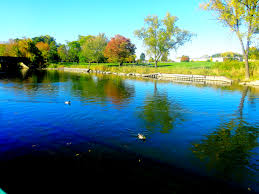
By Mary Manering and Jan Axelson
Friends of Cherokee Marsh
Paddlers love the stretch of the Yahara River that meanders through Cherokee Marsh; and this past summer and fall, they encountered an additional treat — the water was exceptionally clear. Casual observations by paddlers were confirmed by Mary Manering and Dennis Tande, who have been monitoring stream health along this stretch of the Yahara River since 2014.
The monitoring effort is part of a larger team of citizen scientists who volunteer with the Rock River Coalition to collect information on stream health in the Yahara River watershed. Every month from April through November, volunteers monitor at the School Road boat landing and the Highway 113 bridge. To measure water clarity, they use a Secchi disk, a 4-foot long transparent tube with a black and white patterned disk at the bottom.
They fill the tube with water from the river, and then observe from the top of the tube while a valve slowly releases the water. When they can see the disk, they record the water depth in the tube — the higher the reading, the clearer the water. A reading of 120 cm (47 inches), the highest the Secchi disk can measure, occurs when they can see the disk before releasing any water.
In 2017 at the boat landing, there were readings of 120 cm in four of the eight months of testing. The results were similar at Highway 113. Compared to previous years, high readings that extend over so many months are unusual, although 2016 had five readings of 115–120 cm.
The clear water has prompted many conversations about the possible reasons. Perhaps it’s the result of multiple factors, including recent carp harvests, an increase in large beds of aquatic plants in the river and the absence of big storm events. Another possible cause for increased water clarity is zebra mussels, a non-native species that filters the water as it feeds. We are not aware of any reports of invasive zebra mussels in the marsh, but they could be present.
What will this year bring? To learn if the trend for clearer water continues, volunteers will continue monitoring the sites in 2018 and beyond.
An expanded version of this article is in the February/March Friends of Cherokee Marsh newsletter at Cherokeemarsh.org.